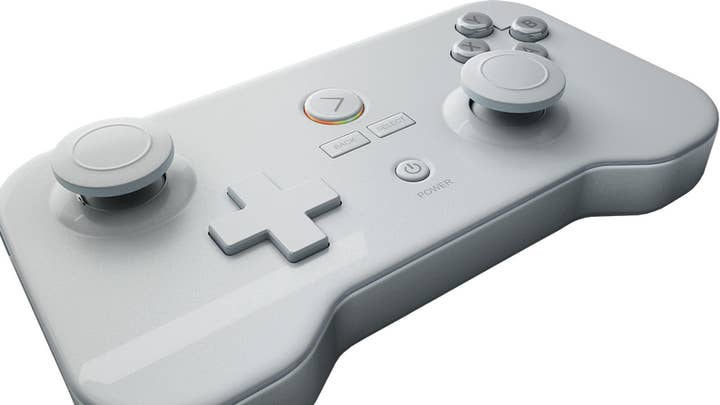GameStick: Selling the Shop Window
CMO Anthony Johnston on the UK's entry to the micro-console market
At the moment, smart TV feels a bit like the firework that never went off. Touted as the next big monetiser for a couple of years by the great and the good, smart TV is a topic which has since largely disappeared from the programmes of conferences and the columns of sites like ours. Whilst it's worth remembering that for many years mobile gaming was thought to be always the bridesmaid and never the bride, smart TV simply doesn't have that critical mass of market penetration yet, nor is the technology proceeding as remarkably fast.
It's not dead by any means, though, with millions of connected TVs on the market around the globe, and a healthy crop of platforms and services offering games to support them. PlayJam offers one of those platforms, available on Samsung, Panasonic, LG, Western Digital, Vizio and Google TVs, so why is it entering into hardware market with it's GameStick microconsole?
"My dad is not a gamer," PlayJam CMO Anthony Johnston tells me, by way of a roundabout explanation. "Getting a smartphone made him a gamer. They changed the industry forever - we want to bring that back to the home of gaming, which is the TV.
"Hardcore gamers aren't likely to buy it, but we're not going after them. We're going after casual and mid-core gamers who, because of the smartphone revolution, have really discovered their love of play"
"We've got a massive potential market which is growing steadily whilst the traditional console audience is just flattening. Their top-down, subsidised hardware model isn't working. It's not sustainable. We're totally the opposite. We're a bottom-up approach, with the price point as low as possible, with the games available at 99c, 99p and up. Make it simple, make it obvious and people will buy it."
Somewhere in there is a tacit acceptance that smart TV has yet to become the challenger which is was so vaunted as, but PlayJam isn't getting out of the business yet. In fact, there's a hope that, if and when the potential of the market is fulfilled, that GameStick tech will become a part of smart TVs themselves.
"We're starting to see Android integrated into smart TVs," Johnston continues. "Samsung and LG have invested a lot of money into building their own app stores. What Android gives you is massive scale. There are 75,000 Android games out there. There's still some fragmentation on Android devices, but it's about as close as you can get without being Apple. It's a phenomenal operating system, and it's very much what's behind this drive towards what we're promoting, which is affordable gaming.
"I'm very much hoping that smart TV manufacturers will start to adopt it. We'll continue to work with those guys. It's still very much a core focus of the business, but the Android operating platform has given us so much; it's plugged us in to a massive, ready-to-go ecosystem, which is why it's so exciting."

Really though, GameStick appears to be something of a shop window for a shop window. As well as being a product in its own right (with considerable demand) it's also there as an example of a viable hardware access to the PlayJam store.
"Gamestick is another piece of hardware that enables a version of our platform," Johnston explains when I ask about the invitation to other hardware manufacturers. "In the future you might see that platform on a Verizon set-top box, just about anything. As a company we are making available all of the technology that powers Gamestick to anyone who wants to come into the hardware market and have a gaming solution.
"We're not going to be the only people to do this. If you're a company and you're going to bring a product to market, you're probably going to be a hardware company rather than a software company. So we say to them, go and make the best piece of hardware that you can and don't worry about the millions of pounds of investment that you'd otherwise have to make to power a decent games proposition - we'll supply it for you.
"So that's the mile-high top-down look on where we want the market to go and why we think we're different from everyone else. We've been doing TV gaming for 12 years, it's in our DNA, and we want it to go massive. We want to see the industry explode."
There's a chicken and egg situation here, in that the platform itself needs to exhibit some success before it attracts other hardware manufacturers, but once that cycle has been escaped, success should hopefully breed success and see the ecosystem expanding exponentially.
Whether those additional hardware propositions will start rolling in without the promise of kickbacks from future game sales remains to be seen, but for now the GameStick itself is a technically solid proposition. Blown up to 42" screens at the GDC demo event, the games on show have visual fidelity which comes partly from a clever use of shading and flat texturing, but also owes something to what's under the compact plastic hood.
"If we optimise the platform to the ARM architecture and the AM logic chipset, then that effectively means that we can have our storefront ready to go on anything that utilises that chipset"
"I think that's all down to the processor," says Johnston. "There are advantages and disadvantages to producing a console in the UK, and one of the big advantages is having ARM around the corner. There are huge American companies who would do anything for a contact at ARM, and they're just embracing us. They told us that they want to use Gamestick as the reference platform for console gaming for ARM. Their dev community is huge, so we're really excited. We're very close to the Amlogic guys too, which has meant that we've been able to optimise the hardware perfectly.
"If we optimise the platform to the ARM architecture and the AM logic chipset, then that effectively means that we can have our storefront ready to go on anything that utilises that chipset. Set-top boxes, smart TV etc. So it's very much a big play for Playjam. We operate a games platform, we have done for years, it powers games on over 60 million smart TVs worldwide."
That hardware selection keeps costs down and helps to control heat - a key consideration for a small form-factor device without any cooling. 8Gb of storage exists in the controller itself, with a slot to expand that by a further 32Gb. A charging dock, designed at the request of Kickstarter backers, offers another 64Gb slot.
"The dock was another thing that we had no specifications for originally. During the campaign people were saying that they really wanted to use it as a media centre, or for Skype. They couldn't do that because there were no ports on the original stick. So we came up with the dock in three days and put it back up on Kickstarter. We've had near a 50 per cent attach rate for it, people have gone crazy."
Crucially, for developers, the proposition is a simple one. Sign up, obtain the SDK and transpose your controls to a pad instead of a touchscreen, clean up the UI a little and you can be on the storefront in less than a month. PlayJam are also offering the 70/30 split which has quickly become the industry standard, across game purchases, IAP and advertising revenues, giving developers complete control over how they monetise their games.
Alongside Ouya, the GameStick sits in an odd position somewhere between smartphone, console and handheld, but could offer a boon to regular travellers and parents looking for a cheaper console alternative, as well as another front of exposure for hungry Android developers. Whether it will be the spark to ignite the dormant fuse atop the smart TV firecracker remains to be seen, but don't write either off just yet.

